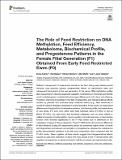Por favor, use este identificador para citar o enlazar a este item:
http://hdl.handle.net/10261/258154COMPARTIR / EXPORTAR:
 SHARE SHARE
 CORE
BASE CORE
BASE
|
|
| Visualizar otros formatos: MARC | Dublin Core | RDF | ORE | MODS | METS | DIDL | DATACITE | |

| Título: | The role of feed restriction on DNA methylation, feed efficiency, metabolome, biochemical profile, and progesterone patterns in the female filial generation (f1) obtained from early feed restricted ewes (F0) |
Autor: | Andrés, Sonia CSIC ORCID ; Madsen, O.; Montero, Olimpio CSIC ORCID CVN ; Martín González, Alba CSIC ORCID; Giráldez, Francisco Javier CSIC ORCID | Palabras clave: | Feed efficiency Nutritional programming Feed restriction Progesterone Cholic acid Metabolomics Epigenetics |
Fecha de publicación: | 2021 | Editor: | Frontiers Media | Citación: | Frontiers in physiology, 12: 779054 (2021) | Resumen: | Deficient management of replacement animals in the farm during early developmental windows may promote adverse programming effects on reproductive traits and subsequent transmission to the next generation. In this sense, DNA methylation profiles allow researchers to decode epigenetic regulation mechanisms in mammals and identify novel candidate genes correlated with phenotype differences in both dams and offspring. Therefore, improving knowledge in the field of epigenetics and intergenerational effects caused by prenatal and postnatal early nutritional events (e.g., feed restriction) is crucial for refining strategies dedicated to animal breeding. In this study, we determined differences in the global blood methylation patterns, biochemical profile, and metabolome of ewe lambs (F1) born from either early feed restricted dams (F0-RES) or fed ad libitum (F0-ADL). Our data show that functional categories such as those related to cellular processes, phosphorylation, nervous system, immunity response, or reproductive function were enriched significantly in the F1-RES lambs due to differences in the methylation of genes in these categories. These F1-RES lambs did not show differences in feed efficiency during the replacement period but presented higher levels of insulin and triglycerides and reduced concentration of progesterone, whereas the metabolome profile demonstrated variations in the bile acid composition when compared with the F1-ADL lambs. Taken together, all these results suggest that intergenerational effects caused by early feed restriction of dams (F0) may persist in the F1 female lambs with negative consequences on genes involved in cellular processes and reproductive traits. | Descripción: | 12 páginas, 1 figura, 4 tablas. | Versión del editor: | http://dx.doi.org/10.3389/fphys.2021.779054 | URI: | http://hdl.handle.net/10261/258154 | DOI: | 10.3389/fphys.2021.779054 | E-ISSN: | 1664-042X |
| Aparece en las colecciones: | (IGM) Artículos (IBGM) Artículos |
Ficheros en este ítem:
| Fichero | Descripción | Tamaño | Formato | |
|---|---|---|---|---|
| Andres, S_fphys_2021.pdf | Artículo principal | 385,2 kB | Adobe PDF |  Visualizar/Abrir |
CORE Recommender
SCOPUSTM
Citations
3
checked on 05-may-2024
WEB OF SCIENCETM
Citations
3
checked on 27-feb-2024
Page view(s)
81
checked on 07-may-2024
Download(s)
76
checked on 07-may-2024
Google ScholarTM
Check
Altmetric
Altmetric
Este item está licenciado bajo una Licencia Creative Commons

